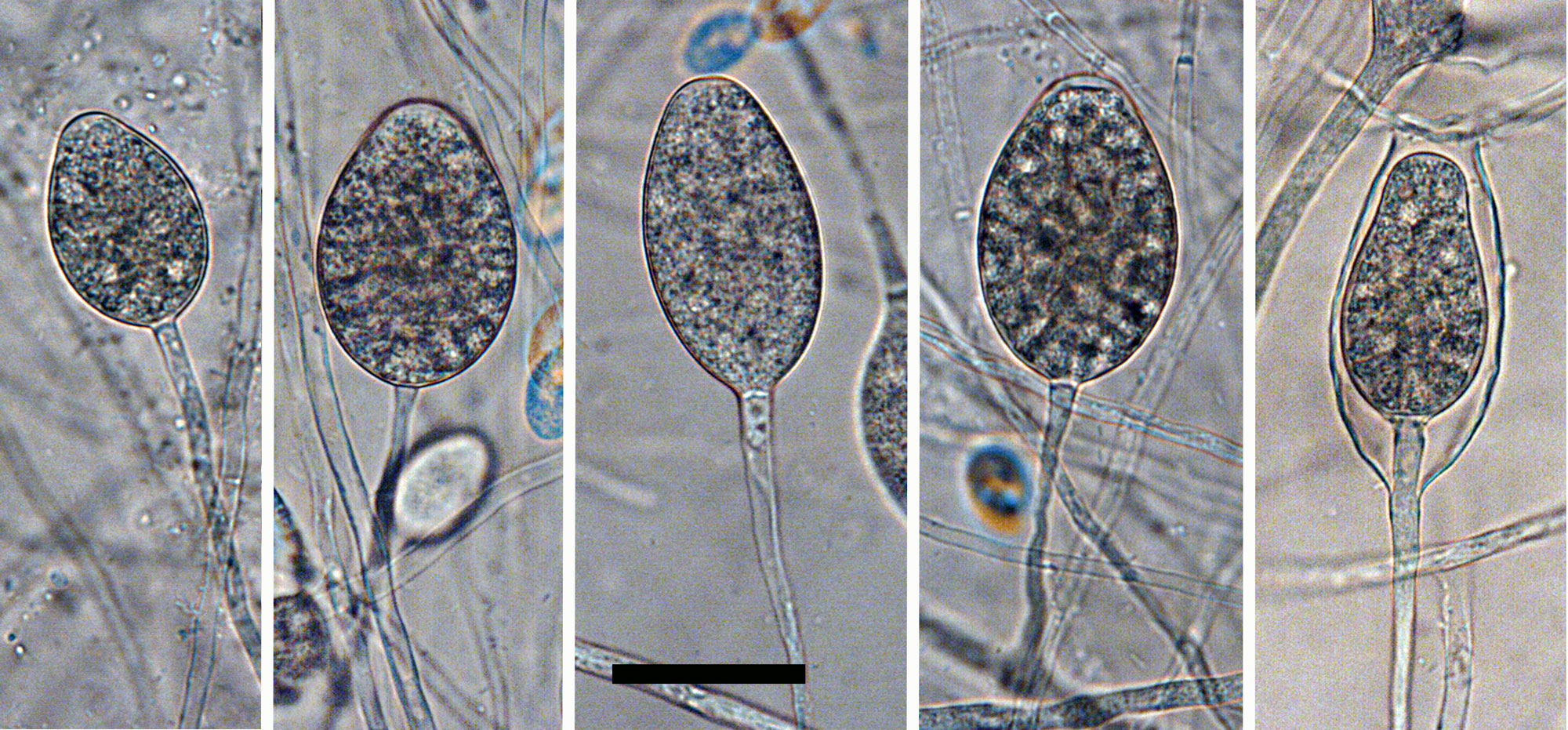Phytophthora oreophila
|
Phytophthora spp. in subclade 6a: portion of the seven-loci ML phylogeny featuring the type cultures of 212 described species (by T. Bourret). Notice the position of P. oreophila Ex-type CBS 144708. Gloria Abad, USDA S&T.
|
|
Phytophthora spp. in subclade 6a: Morphological Tabular key (PDF) and Tabular key legends (PDF) in IDphy2 KEY SECTION. Notice the data of P. oreophila Ex-type CBS 144708. Gloria Abad, USDA S&T.
|
|
colony morphology after 5 d growth at 20ºC on carrot agar, V8 agar, malt extract agar, and potato-dextrose agar (from left to right) |
|
persistent, non-papillate, predominantly ovoid sporangia; scale bar = 25µm. |
|
Oogonia with wavy walls containing aplerotic oospores, with large ooplasts which turn pale brown on maturity. Antheridia were exclusively paragynous, generally situated adjacent to the oogonial stalk; scale bar = 25µm. |
Name and publication
Phytophthora oreophila I. Khaliq and T.I Burgess (2019)
Khaliq I, Hardy GE, McDougall KL, Burgess TI. 2019. Phytophthora species isolated from alpine and sub-alpine regions of Australia, including the description of two new species; Phytophthora cacuminis sp. nov and Phytophthora oreophila sp. nov. Fungal Biology 123 (1): 29–41.
Corresponding author: tburgess@murdoch.edu.au (T.I. Burgess).
Nomenclature
Mycobank
Etymology
‘oreos’ refers to a Greek word for a mountain and ‘phila’ means loving. The name is given to the species due to its mountainous origin, and its ability to grow at extremely low temperatures (less than 4°C).
Typification
Type: Australia: New South Wales, Merritts Creek; by baiting rhizosphere soil and associated roots collected from a disturbed alpine herbfield, Jan 2016. Collected by Keith McDougall, isolated by I. Khaliq. Holotype MURU 483 (dried culture on V8A, Herbarium of Murdoch University, Western Australia)
Ex-type: culture CBS 144708 = U11
Sequences of ex-type in manuscript: ITS MG542976, β-tubulin MG543037, HSP90 MG543025, cox1 MG543002, nadh1 MG543013
Ex-type in other collections
(ET) CBS 144708, U11
Molecular identification
Voucher sequences for barcoding genes (ITS rDNA and COI) of the ex-type (see Molecular protocols page)
Phytophthora oreophila ITS rDNA, COI
Voucher sequences for Molecular Toolbox with seven genes (ITS, β-tub, COI, EF1α, HSP90, L10, and YPT1
(see Molecular protocols page) (In Progress)
Voucher sequences for Metabarcoding High-throughput Sequencing (HTS) Technologies [Molecular Operational Taxonomic Unit (MOTU)]
(see Molecular protocols page) (In Progress)
Sequences with multiple genes for ex-type in other sources
- NCBI: Phytophthora oreophila
- EPPO-Q-bank: Phytophthora oreophila
- BOLDSYSTEMS: Phytophthora oreophila
Position in multigenic phylogeny with 7 genes (ITS, β-tub, COI, EF1α, HSP90, L10, and YPT1)
Clade clade:
a taxonomic group of organisms classified together on the basis of homologous features traced to a common ancestor
6a
Morphological identification
Colonies and cardinal temperatures
Colony colony:
assemblage of hyphae which usually develops form a single source and grows in a coordinated way
morphology on V8 agar and CA was slightly petaloid, and rosaceous on PDA. Minimum growth temperature 4°C, optimum 20°C, and maximum 32.5°C.
Conditions for growth and sporulation
SporangiaSporangia:
sac within which zoospores form, especially when water is cooled to about 10°C below ambient temperature; in solid substrates, sporangia usually germinate by germ tubes
are produced in water cultures (soil extract) and not observed in solid media. OogoniaOogonia:
the female gametangium in which the oospore forms after fertilization by the antheridium
are formed readily in single-strain culture on CA and V8 after about 14 d.
Asexual phase
SporangiaSporangia:
sac within which zoospores form, especially when water is cooled to about 10°C below ambient temperature; in solid substrates, sporangia usually germinate by germ tubes
were non-papillate, persistentpersistent:
pertaining to sporangia that remain attached to the sporangiophore and do not separate or detach easily (cf. caducous)
, and predominantly ovoidovoid:
egg-shaped, with the widest part at the base of the sporangium and the narrow part at the apex
in shape with internal proliferationinternal proliferation:
internal proliferation occurs when the sporangiophore continues to grow through an empty sporangium
, both nested and extended. SporangiaSporangia:
sac within which zoospores form, especially when water is cooled to about 10°C below ambient temperature; in solid substrates, sporangia usually germinate by germ tubes
averaged 40.9 x 26.7 µm (overall range 19.9–59.9 x 13.4–38.5 µm). Sporangiophores simple. Hyphal swellings present. ChlamydosporesChlamydospores:
an asexual spore with a thickened inner wall that is delimited from the mycelium by a septum; may be terminal or intercalary, and survives for long periods in soil
absent.
Sexual phase
Homothallic. OogoniaOogonia:
the female gametangium in which the oospore forms after fertilization by the antheridium
had wavy walls and size ranged from 29.3–48.1 µm OosporesOospores:
zygote or thick-walled spore that forms within the oogonium after fertilization by the antheridium; may be long-lived
pleroticplerotic:
pertaining to an oospore that fills the oogonium (cf. aplerotic)
, globoseglobose:
having a rounded form resembling that of a sphere
with a large ooplast and pale on maturity, size ranged 26.8–42 µm. 90% of oosporesoospores:
zygote or thick-walled spore that forms within the oogonium after fertilization by the antheridium; may be long-lived
aborted after formation of the walls. AntheridiaAntheridia:
the male gametangium; a multinucleate, swollen hyphal tip affixed firmly to the wall of the female gametangium (the oogonium)
paragynous often with multiple antheridiaantheridia:
the male gametangium; a multinucleate, swollen hyphal tip affixed firmly to the wall of the female gametangium (the oogonium)
.
Most typical characters
Phytophthora oreophila is closely related to and morphologically resembles P. rosacearum and P. pseudorosacerum; the most distinguishing characteristics are the lower temperature optima and faster growth.
Hosts and distribution
Distribution: Australia
Substrate: roots
Disease note: no known disease
Host: native vegetation
Additional references and links
- SMML USDA-ARS: Phytophthora oreophila
- EPPO Global Database: Phytophthora oreophila
- Forest Phytophthoras of the world: Phytophthora oreophila
- CABI Digital Library: Phytophthora oreophila
- Encyclopedia of Life (EOL): Phytophthora oreophila
- Index Fungorum (IF): Phytophthora oreophila
Fact sheet author
Treena Burgess, Ph.D., Phytophthora Science and Management, Harry Butler Institute, Murdoch University, Australia
Z. Gloria Abad, Ph.D., USDA-APHIS-PPQ-S&T Plant Pathogen Confirmatory Diagnostics Laboratory (PPCDL), United States of America.




